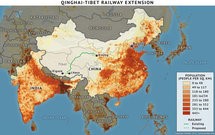 China plans to extend the Qinghai-Tibet railway to the southern Tibetan city of Xigaze, located less than 160 kilometers (100 miles) from the border with India. The railway extension, which authorities expect to be operational by October, is ostensibly intended to improve access for Tibetans and other Buddhist pilgrims to the Beijing-installed Panchen Lama -- the highest reincarnated lama after the Dalai Lama and the highest recognized by Beijing -- whose official seat is in Xigaze.
China plans to extend the Qinghai-Tibet railway to the southern Tibetan city of Xigaze, located less than 160 kilometers (100 miles) from the border with India. The railway extension, which authorities expect to be operational by October, is ostensibly intended to improve access for Tibetans and other Buddhist pilgrims to the Beijing-installed Panchen Lama -- the highest reincarnated lama after the Dalai Lama and the highest recognized by Beijing -- whose official seat is in Xigaze.
At the same time, authorities say the rail line will open the way for increased Chinese and foreign tourism throughout Tibet, thus increasing the region's economic integration with and reliance on the rest of China. The railway will also extend China's infrastructural (and therefore security) footprint deep into Tibet.
The extension plan taps into a number of overlapping themes in contemporary Chinese geopolitics. Fundamentally, it must be understood in the context of China's centuries-old struggle to gain and maintain control of buffer regions such as Tibet, Xinjiang, Inner Mongolia and Manchuria. When controlled by Han China, these largely impassable regions form a shell around the country's vulnerable lowland core, providing strategic depth from other Eurasian population cores.
Historically, when Han China has been strong it has enjoyed greater control over these buffer regions. Authority over the borderlands, in turn, is necessary for a secure Han China. But these areas traditionally have been tenuously integrated into Han cultural and economic spheres of influence. Therefore, when Han China weakens, these regions are often the first to break away, precipitating the disintegration of the core itself.
With this historical pattern in mind, China's current leadership has moved aggressively in recent years to bolster Han economic and demographic dominance in the borderlands. Part of this strategy has involved physically binding the borderlands to the Han Core through extensive road, rail and other infrastructure development. For Beijing, the ultimate goal is to neutralize the inherited geopolitical dynamic between the core and peripheral regions by cementing Chinese control -- physically, demographically, economically and militarily -- over the borderlands.
Courtesy : Stratfor (www.stratfor.com)